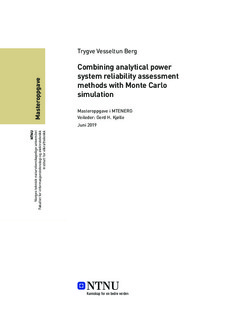| dc.contributor.advisor | Gerd H. Kjølle | |
| dc.contributor.author | Trygve Vesseltun Berg | |
| dc.date.accessioned | 2019-10-31T15:19:58Z | |
| dc.date.available | 2019-10-31T15:19:58Z | |
| dc.date.issued | 2019 | |
| dc.identifier.uri | http://hdl.handle.net/11250/2625901 | |
| dc.description.abstract | Denne masteroppgaven undersøker fagfeltet pålitelighetsanalyse av kraftsystemer gjennom to deler,
et litteraturstudie om det nye innen metoder for pålitelighetsanalyse av kraftsystemer, og en implementasjon
av to hybridmetoder for kraftsystemanalyse testet på to testsystemer for pålitelighet.
Metoder for pålitelighetsanalyse kan deles inn i to grupper, analytiske metoder og Monte Carlo
simulering. Begge metodetypene blir evaluert i forhold til deres fordeler og ulemper. Etter at karakteristikkene
for alle presenterte metodene har blitt undersøkt, så diskuteres det rundt det å kombinere
ulike metoder til hybridmetoder. Ideen er å lage hybridmetoder som forsterker fordelene og
minimerer ulempene fra begge de kombinerte metodene. To mulige hybridmetoder blir foreslått: 1)
en kombinasjon av OPAL-metoden med state sampling Monte Carlo simulering, 2) en kombinasjon
av OPAL-metoden med pseudo-sekvensiell Monte Carlo simulering. Begge metodene blir testet på
to testsystemer, RBTS og Fire-Område Testnettverket.
Simuleringsresultater blir funnet for både leveringspunkter i systemet, og for det totale systemet.
Resultatene viser at hybridmetodene klarer å regne på pålitelighetsindeksene, som måler påliteligheten
til et kraftsystem. OPAL-metoden blir brukt som referansemåling for sammenlikning med
resultatene fra simulering av hybridmetodene. Pålitelighetsindeksen for det totale systemets forventet
ikke-levert energi (ENG: EENS) blir beregnet til å ha en maksimum differense på 2.8% mellom
hybridmetodene og OPAL-referansemålingen. Begge testsystemene har over 95% av bidragene til
EENS-indeksen fra utfall av en enkelt gren. Pålitelighetsindeksene beregnet for hybridmetodene og
referansemålingen, varierer mer for RBTS enn for fire-område testnettverket, mest sannsynlig på
grunn av at fire-område testnettverket er mye mer pålitelig enn RBTS.
Sammenlignet med OPAL-metoden, så kommer begge hybridmetodene med en økt beregningskostnad.
Mange forbedringer kan gjøres for begge hybridimplementasjonene for å redusere
denne beregningskostnaden, inkludert: optimere/omstrukturere koden, inkludere teknikker for variansereduksjon, kombinering med intelligente metoder (som partikkelsverm-optimering, genetiske
algoritmer, maskinlærings-algoritmer osv.). Begge de foreslåtte hybridmetodene kan bli brukt for
å evaluere pålitelighet av kraftsystemer, men mer testing, og forbedring, behøves for at metodene
muligens skal kunne etablere seg som mer treffsikre enn den analytiske pålitelighetsanalysemetoden
OPAL, eller raskere, og like treffsikker, som Monte Carlo simuleringsmetodene. | |
| dc.description.abstract | This master thesis examines the field of power system reliability assessment through two parts, a
literature study on the state of the art within power system reliability analysis methods, and an
implementation of two hybrid power system reliability analysis approaches tested on two reliability
test systems.
The reliability analysis methods can be divided into two groups, analytical methods and Monte
Carlo simulation. The advantages and disadvantages of both types of methods are evaluated. After
the characteristics of each method has been established, a discussion regarding combination of reliability
methods into hybrid approaches ensues. The idea is to create hybrid methods that enhance
the advantages of both methods while minimizing the disadvantages of both methods. Two possible
hybrid reliability method configurations are proposed: 1) A combination of the OPAL methodology
based on contingency enumeration and state sampling Monte Carlo simulation, 2) A combination
of the OPAL methodology based on contingency enumeration and pseudo-sequential Monte Carlo
simulation. Both methods are tested on two test systems, RBTS and The Four-Area Test Network.
Simulation results are obtained for both the delivery points of the system, as well as the system
as a whole. The hybrid methods are able to calculate the reliability indices, which measures the
reliability of a power system. As a benchmark for comparison of the simulation results from the hybrid
methods, the OPAL method is used. The total system index for Expected Energy Not Supplied
(EENS) is calculated to be at a maximum difference of 2.8% between the hybrid methods and the
OPAL Benchmark test. Both test systems have over 95% of the contribution to the EENS index from
one single branch outage, due to the islanding of a bus. The reliability indices calculated for the
two hybrid methods and the benchmark on the RBTS network differs more than for The Four-Area
Network, which is likely due to the fact that The Four-Area Network is much more reliable than
RBTS.
The hybrid methods have higher computational cost compared to the OPAL method. Many improvements
can be made on both hybrid implementations to reduce computational cost, including:
optimizing of code, combine with intelligent techniques (variance reduction, particle swarm optimization,
genetic algorithms, machine learning algorithms etc.). Both proposed hybrid methods can
be used for reliability assessment of power systems, but further testing and improvement is required
in order possibly be established as a more accurate method than the analytical reliability analysis
method OPAL, or faster, and sufficiently accurate, than the Monte Carlo simulation methods. | |
| dc.language | eng | |
| dc.publisher | NTNU | |
| dc.title | Combining analytical power system reliability assessment methods with Monte Carlo simulation | |
| dc.type | Master thesis | |
